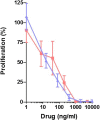Anti-CD28 Antibody and Belatacept Exert Differential Effects on Mechanisms of Renal Allograft Rejection
- PMID: 27160407
- PMCID: PMC5118475
- DOI: 10.1681/ASN.2015070774
Anti-CD28 Antibody and Belatacept Exert Differential Effects on Mechanisms of Renal Allograft Rejection
Abstract
Belatacept is a biologic that targets CD80/86 and prevents its interaction with CD28 and its alternative ligand, cytotoxic T lymphocyte antigen 4 (CTLA-4). Clinical experience in kidney transplantation has revealed a high incidence of rejection with belatacept, especially with intensive regimens, suggesting that blocking CTLA-4 is deleterious. We performed a head to head assessment of FR104 (n=5), a selective pegylated Fab' antibody fragment antagonist of CD28 that does not block the CTLA-4 pathway, and belatacept (n=5) in kidney allotransplantation in baboons. The biologics were supplemented with an initial 1-month treatment with low-dose tacrolimus. In cases of acute rejection, animals also received steroids. In the belatacept group, four of five recipients developed severe, steroid-resistant acute cellular rejection, whereas FR104-treated animals did not. Assessment of regulatory T cell-specific demethylated region methylation status in 1-month biopsy samples revealed a nonsignificant trend for higher regulatory T cell frequencies in FR104-treated animals. Transcriptional analysis did not reveal significant differences in Th17 cytokines but did reveal higher levels of IL-21, the main cytokine secreted by CD4 T follicular helper (Tfh) cells, in belatacept-treated animals. In vitro, FR104 controlled the proliferative response of human preexisting Tfh cells more efficiently than belatacept. In mice, selective CD28 blockade also controlled Tfh memory cell responses to KLH stimulation more efficiently than CD80/86 blockade. Our data reveal that selective CD28 blockade and belatacept exert different effects on mechanisms of renal allograft rejection, particularly at the level of Tfh cell stimulation.
Keywords: acute rejection; immunology; immunosuppression; kidney transplantation; lymphocytes.
Copyright © 2016 by the American Society of Nephrology.
Figures








References
-
- Vincenti F, Larsen C, Durrbach A, Wekerle T, Nashan B, Blancho G, Lang P, Grinyo J, Halloran PF, Solez K, Hagerty D, Levy E, Zhou W, Natarajan K, Charpentier B; Belatacept Study Group : Costimulation blockade with belatacept in renal transplantation. N Engl J Med 353: 770–781, 2005 - PubMed
-
- Vincenti F, Charpentier B, Vanrenterghem Y, Rostaing L, Bresnahan B, Darji P, Massari P, Mondragon-Ramirez GA, Agarwal M, Di Russo G, Lin C-S, Garg P, Larsen CP: A phase III study of belatacept-based immunosuppression regimens versus cyclosporine in renal transplant recipients (BENEFIT study). Am J Transplant 10: 535–546, 2010 - PubMed
-
- Poirier N, Mary C, Dilek N, Hervouet J, Minault D, Blancho G, Vanhove B: Preclinical efficacy and immunological safety of FR104, an antagonist anti-CD28 monovalent Fab’ antibody. Am J Transplant 12: 2630–2640, 2012 - PubMed
-
- Poirier N, Azimzadeh AM, Zhang T, Dilek N, Mary C, Nguyen B, Tillou X, Wu G, Reneaudin K, Hervouet J, Martinet B, Coulon F, Allain-Launay E, Karam G, Soulillou JP, Pierson RN 3rd, Blancho G, Vanhove B: Inducing CTLA-4-dependent immune regulation by selective CD28 blockade promotes regulatory T cells in organ transplantation. Sci Transpl Med 2: 17ra10, 2010 - PMC - PubMed
MeSH terms
Substances
LinkOut - more resources
Full Text Sources
Other Literature Sources
Research Materials

